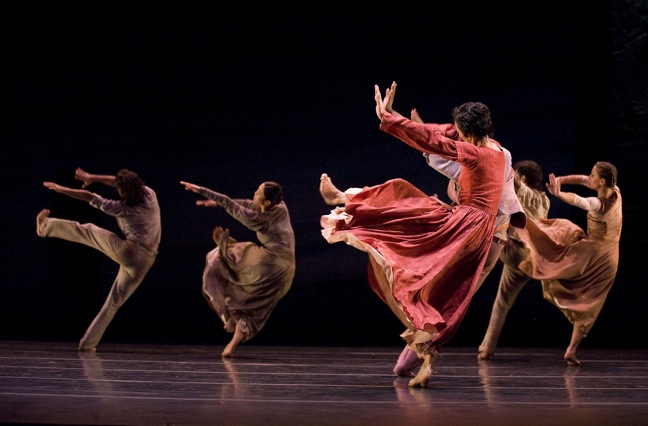
Blue, I want you blue …
As an epigraph to Nacho Duato’s ballet “Cobalto,” presented this past weekend at Yerba Buena for the Arts’ Novellus Theater by Compañia Nacional de Danza de España, the program notes cite a quotation by Goethe: “It is like a color (blue) and energy, but it belongs to the negative side, and in its supreme purity it is, as one would say, a precious nothingness. Its effect is a mixture of excitation and serenity.”
The notes go on to tell that the ballet is about eroticism. The dance, which is set to organ music by composers Luis Alcalde and Sergio Caballero, opens with only a table center stage and two dancers. A man writhes below, winding between the table’s long legs, seeming to battle ever upward toward the woman above; the woman clings close to the tabletop, reaching down to man below even as her body draws its own figures of physical longing. There is a hard surface between them, an impediment, a metaphor. Would there be less between them if there were no table? Or do their bodies form the barrier the table describes, even as their desires urge them on toward intimacy?
Two men replace them; the table disappears replaced by a long curtain of silver chains spanning upstage. The men are like shadowy twins, repeating steps, synchronized paeans to bondage. They are figures from a nightmare of repressed desire.
A rock dude tangled in his own shirt takes their place, swaying to the chords of the organ. A woman in a sheer black short dress confronts him; the couple doubles, quadruples. Tables appear from the wings, and when the women place the furniture together in the center of the stage the table legs form a cage.
“Cobalto” is typical of the choreographer Nacho Duato’s work—complex, athletic yet lyrical, dark and primordial in its vision; it’s as gloomy in its analogies as a painting by El Greco.
One only need look at early photographs of Duato as a dancer to recognize that the body turned inward toward its own smooth muscularity is the essence of his power. Few dancers, especially ballet dancers, are able to catch this form of beauty; their focus is more often on line and agility.
This is not to say that Duato’s work lacks agility, to the contrary, it is restless, near seething in its movement; but, rather, that there is a brooding energy within the choreography that is born out of compression rather than expansion.
There is also something contemplative in Duato’s approach, which moderates the complexities of interaction that spring forth continuously, requiring precisions of balance and resolution. Like his mentor, Maurice Béjart, Duato uses improbable and ungainly movement in his choreography, but he is often more successful in doing so, eschewing some of Béjart’s tendency to use-it-because-I-can choreography, a commitment to the intellectual that now and again rendered Béjart’s work preposterous.
The other two works on the program were “Kol Nidre,” a homage to young men in war, in which the dancers, crawling over, under and through one other, trace Boschian gesticulations that are both unexpected and grotesque—sand bags are the barriers behind which the dancers hide from gunfire; the curtain closing with a solitary figure caught in the long silvery tubing stretching upward from the floor to the lights—and “Arenal.” “Arenal” is a lyrical ballet alternating between a single female dancer dressed in dark gray and groups of dancers. The music is from Majorcan work songs sung in Catalan by María del Mar Bonet.
After 20 years as its artistic director, Duato is retiring from the Compañia Nacional de Danza de España. We are lucky that San Francisco Performances has brought this fine company here for this celebration of Duato’s work.
—Jaime Robles
Photo: Compañia Nacional de Danza de España dances ‘Arenal’ choreographed by Nacho Duato
